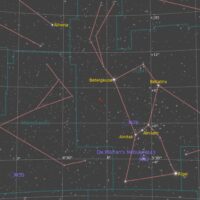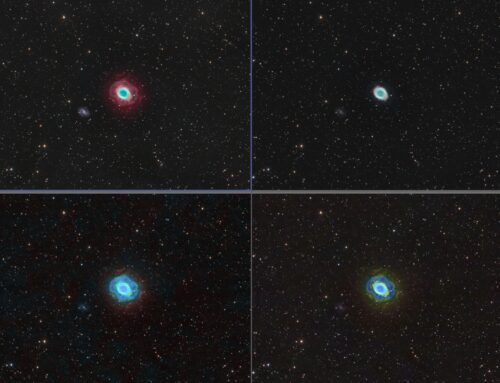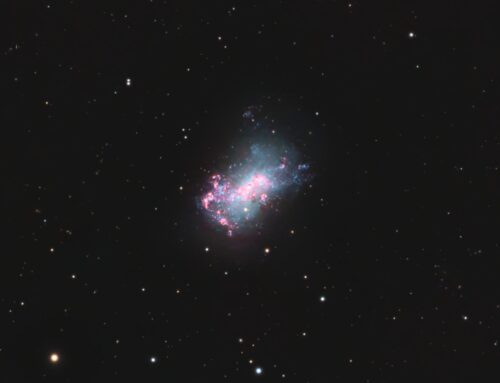Abell 13
 Click image for full size version
Click image for full size version
February 17, 2024
Abell 13 is a very faint planetary nebula located in Orion southeast of Betelgeuse. It is also catalogued as PK 204-08.1. Abell 13 lies about 3,500 light years away. The brightest part of the nebula – the ring – has a size on the sky of about 2.9′ x 2.2′, or about 1/10 the width of a full Moon. I tried to capture some O3 on this, but nothing showed in a 1-hour test, so I used just Ha with broadband colour for this image.
Tekkies:
Acquisition, focusing, and control of Paramount MX mount with N.I.N.A., TheSkyX and PHD2. Primalucelab low-profile 2″ Essato focuser and ARCO rotator. Equipment control with PrimaLuce Labs Eagle 4 Pro computer. All pre-processing and processing in PixInsight. Acquired from my SkyShed in Guelph. Average transparency and seeing. Data acquired under moonless skies February 3-4, 2024.
Celestron 14″ EDGE HD telescope at f/11 (3,912 mm focal length) and QHY600M camera binned 2×2 with Optolong filters.
11 x 2m Red = 0hr 22m
10 x 2m Green = 0hr 20m
10 x 2m Blue = 0hr 20m
57 x 5m Ha = 4hr 45m
Total: 5hr 47m
Preprocessing: The WeightedBatchPreProcessing script was used to perform calibration, cosmetic correction, weighting, registration, local normalization and integration of all frames.
RGB master: A master RGB image was made from the Red, Green and Blue masters using ChannelCombination in RGB mode.
Gradient Removal: DBE was used to remove gradients from the RGB and Ha masters.
Colour Calibration: SpetroptometricColorCalibration was used to calibrate the RGB master.
Deconvolution: BlurXterminator was applied to the two masters with Automatic psf , star sharpening set to 0.4, and non-stellar set to 0.9.
Star Removal: StarXterminator was used to remove the stars from both masters, with default settings, except Large Overlap was selected. Only the RGB stars-only image was retained.
Linear Noise Reduction: NoiseXterminator was applied to the both masters with settings Amount=0.9 and Detail=0.35
Stretching: HistogramTransformation was applied to both masters to make pleasing images. Approximate background level after stretch was 0.09 for Ha and 0.10 for RGB.
Nonlinear Processing
Addition of SynthL to RGB: LRGBCombination was used to replace the L* channel of the RGB image with the SynthL.
Addition of Ha to LRGB: PixelMath was used to blend the Ha master into the LRGB image using the following expression with parameter values a=1.5 and b=0.10.
Red: max($T[0], a*Ha)
Green: $T[1]
Blue: iif($T[0]<a*Ha, $T[2] + b * Ha, $T[2])
Nonlinear Noise Reduction: NoiseXterminator was used to reduce noise in the background areas of both masters with Amount=0.9 and Detail=0.15.
Re-stretch: HistogramTransformation was used to boost contrast by moving the dark point to the toe of the histogram and slightly decreasing the mid-point slider.
Contrast Enhancement: LocalHistogramEqualization was applied three times. A Contrast Limit of 1.5 and 1 iteration was used for each LHE application (scale 40, strength 0.25; scale 90, Strength 0.18; scale 150, strength 0.18).
Sharpening: MultiscaleMedianTransform was applied. (Layers 1 – 5 with strengths of 0.01, 0.02, 0.04, 0.02, and 0.01, respectively), using a mask to select only the nebula.
Contrast, Brightness and Colour: Background and nebula brightness, contrast, and saturation were adjusted in several iterations using CurvesTransformation with masks as required.
Stars-only steps: HistogramTransformation was applied to the RGB stars-only image. A mask was made by using ChannelExtraction to extract the luminance from the image. CurvesTransformation CIE c* slider was used to add boost colour in the stars through the star mask.
Star Restoration: PixelMath expression combine(starless, stars, op_screen()) was used to combine the starless HaLRGB starless image with the stars-only image.
Final Steps: Background, nebula, and star brightness, contrast, hue, and saturation were adjusted in several iterations using CurvesTransformation with masks as required. ICCProfileTransformation (sRGB IEC61966-2.1; Relative Colorimetric with black point compensation) was applied prior to saving as a jpg. The finder chart was made using the FindingChart process.







Leave A Comment